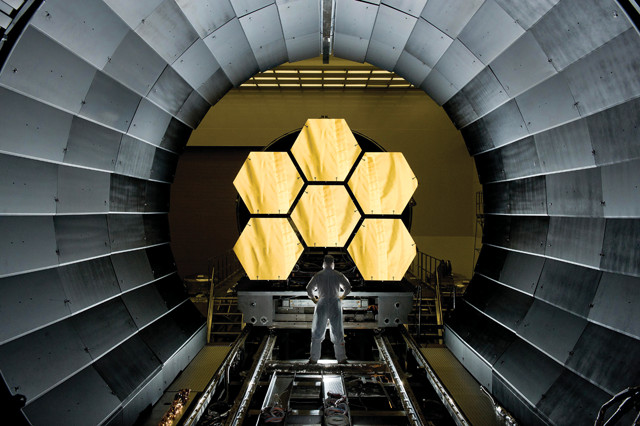
by U.S. Geological Survey Wednesday, June 13, 2018
Brian W. Jaskula, a mineral commodity specialist for the U.S. Geological Survey, compiled the following information on beryllium, which is used in many commercial and military applications.

A NASA engineer looks on as six of the 18 gold-coated beryllium mirrors going on the James Webb Space Telescope are prepped for testing. Credit: NASA/MSFC/David Higginbotham
Beryllium is a lightweight, gray-colored metal. Its physical and mechanical properties — high stiffness-to-weight and strength-to-weight ratios, one of the highest melting points of all light metals, excellent thermal conductivity, outstanding dimensional stability over a wide range of temperatures, reflectivity and transparency to X-rays — make it useful for many applications.
Beryllium is used primarily in beryllium-copper alloys, in beryllium oxide ceramics and as beryllium metal in a wide variety of products such as bearings and bushings, computer-chip heat sinks, contacts and connectors, disc brakes, highly conductive and strong wire, and the output windows of X-ray tubes and other devices.
About 45 percent of the beryllium consumed in the United States in 2011 was used for consumer electronics and telecommunication applications; 12 percent was used for defense-related applications; 11 percent was used for industrial components and commercial aerospace applications; and the remainder was used for appliances, automotive electronics, energy, medical devices and other applications.
Only two minerals are commercially important for the production of beryllium. Bertrandite, which contains less than 1 percent beryllium, is the principal beryllium mineral mined in the United States. Beryl, which contains about 4 percent beryllium, is the principal mineral mined in the rest of the world. The United States is the world’s leading producer of beryllium ore and one of only three countries (the others being China and Kazakhstan) known to process beryllium ores and concentrates into beryllium products.
Primary beryllium facilities produce the feedstock used to make beryllium metal products, and high-purity beryllium is considered both a strategic and a critical material. To ensure a stable beryllium metal supply, in 2011 the Department of Defense helped build a new primary beryllium facility in Ohio through a public-private partnership with the leading U.S. beryllium producer. Prior to that, no primary facilities had been in operation in the U.S. since 2000.
For more information on beryllium and other mineral resources, visit http://minerals.usgs.gov/minerals.
Beryllium production and consumption
World mine production of beryllium was estimated at 240 metric tons in 2011.
The top three producers of mined beryllium in 2011 were the United States (210 metric tons), China (22 metric tons) and Mozambique (2 metric tons).
U.S. apparent consumption of beryllium (including substantial release of beryllium from the U.S. government stockpile) was estimated at 270 metric tons in 2011, and was valued at $121 million.
Fun facts
Beryllium was initially discovered by French chemist Louis-Nicolas Vauquelin in 1798 as a constituent of the mineral beryl.
In 1928, chemists Friedrich Wöhler of Germany and Antoine Bussy of France, working separately, isolated metallic beryllium by reducing beryllium chloride with metallic potassium.
Beryllium, which can be toxic if ingested or inhaled, was initially known as glucinum, due to its sweet taste.
Beryllium oxide is used in global positioning systems and satellite radio and television.
Medical lasers made with beryllium oxide ceramics are used in eye surgery.
NASA’s James Webb Space Telescope, scheduled for launch in 2018, will use 18 beryllium primary mirror segments, which are lightweight and more stable than glass mirrors in the frigid cold of space.
© 2008-2021. All rights reserved. Any copying, redistribution or retransmission of any of the contents of this service without the expressed written permission of the American Geosciences Institute is expressly prohibited. Click here for all copyright requests.